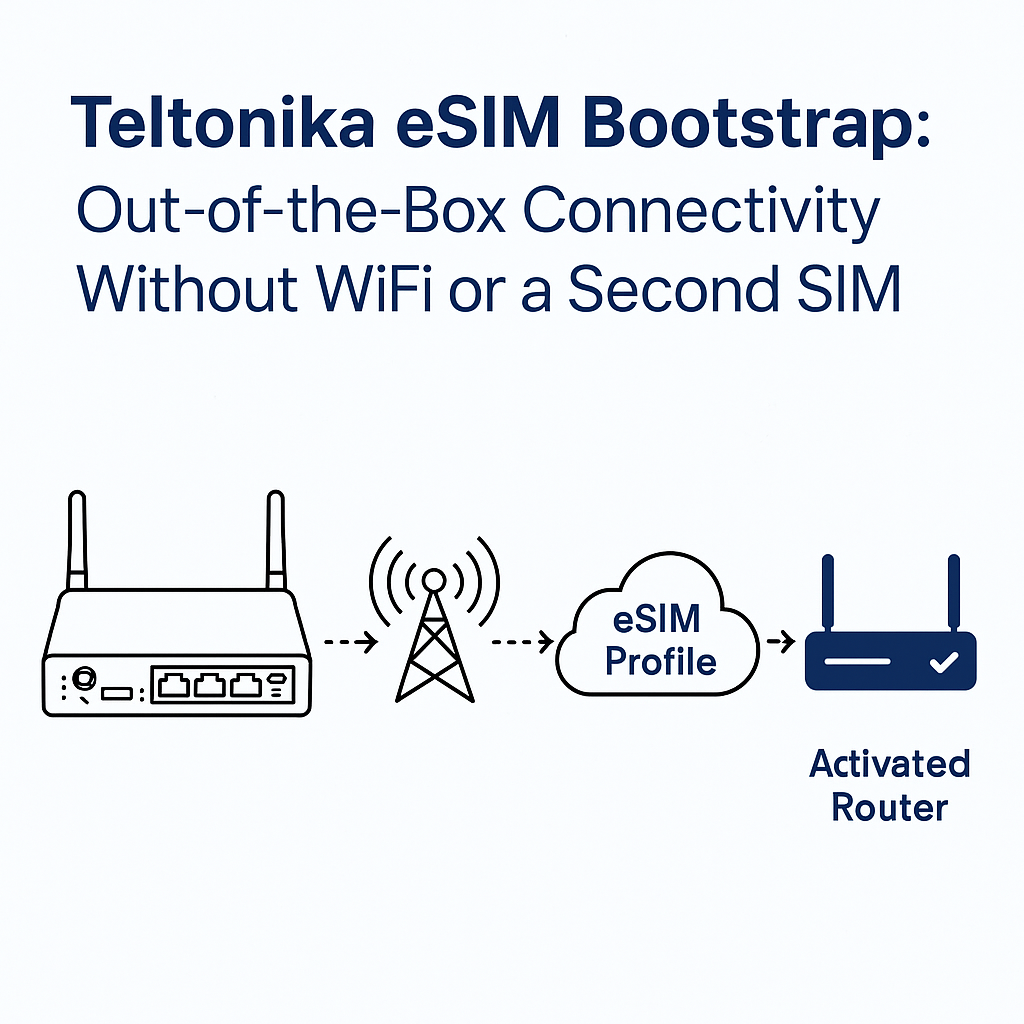
Table of Contents
Deploying new cellular routers used to come with a frustrating catch: to activate an eSIM, you first needed an existing internet connection. That meant using a physical SIM, WiFi, or even a temporary wired connection—just to get the device online so it could download its own cellular profile.
Teltonika Networks has changed that equation with its new eSIM Bootstrap feature, which allows supported routers to activate right out of the box—no extra connections, no support tickets, and no additional hardware required. Let’s explore how it works, why it’s so important, and what it means for network deployments of the future.
What is an eSIM—and why setup has been tricky
An eSIM (embedded SIM) is a programmable chip built directly into the device. Instead of inserting a physical SIM card, an eSIM allows network profiles to be downloaded, switched, or updated over the air.
This makes management easier and eliminates physical handling—but it also creates a chicken-and-egg problem. To download that first profile, the device needs internet access. If there’s no SIM installed and no WiFi available, the eSIM router can’t go online to activate itself.
Historically, installers had to provide a temporary SIM card or another connectivity method just to “bootstrap” the eSIM activation process. That added time, cost, and complexity—especially when deploying routers across hundreds or thousands of sites.
How Teltonika’s eSIM Bootstrap solves this problem
Teltonika’s new eSIM Bootstrap feature provides a smart and simple solution. Each compatible Teltonika router ships with a pre-loaded “bootstrap profile” that includes a small amount of data—just enough to download the full eSIM operator profile automatically.
Here’s how it works:
- When the router powers on, it checks for a physical SIM card.
- If none is found within about an hour, it automatically switches to the eSIM Bootstrap profile.
- The router then connects to Teltonika’s Remote Management System (RMS) and the mobile network operator’s provisioning server.
- The device downloads and installs the full operator eSIM profile.
- Once the download is complete, the router activates normal connectivity and the bootstrap profile goes dormant.
In short, the router uses its own pre-configured mini connection to set itself up—no technician interaction required.
Why this matters for IT teams and IoT deployments
This new feature brings multiple benefits that directly reduce cost, labor, and potential downtime:
| Challenge | How Bootstrap Helps |
|---|---|
| Needing WiFi or a secondary SIM for activation | Eliminated—router connects automatically using its built-in bootstrap profile |
| Failed activations in remote locations | The router can self-activate without any local internet |
| Expensive truck rolls or site visits | Remote provisioning through RMS works immediately |
| Slow large-scale rollouts | Devices can be shipped pre-configured and activate automatically on first power-up |
For system integrators, managed service providers, and organizations with distributed networks, this feature is a major leap forward. Imagine deploying hundreds of devices in locations with no local IT presence—and having them all come online without manual setup. That’s the power of Teltonika’s eSIM Bootstrap.
The bigger picture: Simpler connectivity and fewer support issues
From a support standpoint, eSIM Bootstrap reduces one of the most common pain points in IoT router installations: the “first connection” problem. Because routers now have the means to connect and configure themselves automatically, the need for on-site troubleshooting and manual intervention drops dramatically.
It also improves reliability. If a router loses its primary SIM profile or requires a fresh download, the bootstrap feature ensures it can recover connectivity on its own. That means fewer dead devices and fewer customer support calls.
Looking ahead
Teltonika is gradually expanding this feature across its eSIM-capable router lineup, beginning with popular models like the RUT2 and RUT9 series. For industries like transportation, utilities, manufacturing, and smart cities—where devices are often installed in hard-to-reach areas—this technology is a game-changer.
Final Thoughts
Teltonika’s eSIM Bootstrap isn’t just another incremental update—it’s a fundamental step toward zero-touch deployment. It solves one of the biggest logistical challenges in modern IoT rollouts and makes it easier than ever to connect, manage, and scale cellular networks anywhere in the world.
For organizations that value uptime, scalability, and simplicity, this innovation represents a new era in plug-and-play connectivity. Also, if you are looking for a Teltonika Distributor, check us out.

